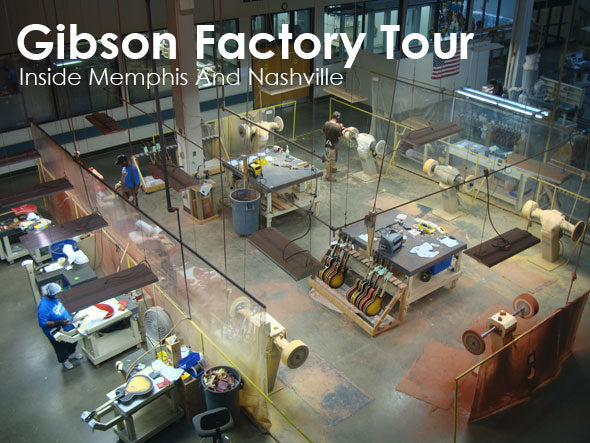Factory Tour: Inside Gibson Guitars
It’s impossible to overstate Gibson’s significance in the history of guitar building – countless Gibson models have found their way into legendary hands and been written into music history. We are all big fans of the guitars and The Music Zoo is proud to be a leading Gibson dealer. We often make trips from New York down to Nashville to have meetings, discuss our custom runs, and learn about future products, and on our last trip we grabbed our camera and toured the Gibson Custom Shop, as well as the inner workings of the factory in Memphis, where archtops and semi-hollow guitars are born. Come along with us as we see what it takes to create a legend.
We don’t want to brag, but we felt like we got the rockstar treatment when we got picked up in the Gibson bus and were chauffeured around. It’s comfortable inside, sure, but nothing helps pass the time like a dozen different Gibsons (Les Pauls, Vs, 335s, SGs) and a wall of Epiphone amps. We chatted with Don Crawford, a veteran driver who has been getting artists to the gig for over 40 years. It was a fun start.
Our first stop was in the Memphis factory. Like we said before, Memphis is where many of the archtops and most of the production semi-hollow guitars (like the ES-335) are made. This factory has been open since 2000 and we were impressed with its clean and organized work areas. Our tour guide was Memphis Production Manager Jason Dawson and the first room he brought us into was hot, humid, and smelled amazingly rich and woody. These sheets of maple will be used to construct the rims of hollowbodies and were sorted according to the figure of the wood.
Don’t panic, Jason wasn’t about to turn his arm into a side for a hollowbody guitar, at least not today. What this press does, is take those thin sheets of maple and press them into the correct shape, adding strength in the process.
Here are the freshly pressed sides, just hanging out.
These purpose-built fitment jigs are used to glue the maple sides together, the first step in constructing the guitar. It was exciting to see this initial step, having seen and played the finished product for so many years.
After the tops and backs are attached to the sides, a router is used to carefully carve away the wood to make room for the binding.
Once the binding is on the guitar the body is essentially complete, and they are wrapped tightly with string while the glue dries. This is done by hand and it’s important to get it nice and snug.
The next step for the guitar bodies is sanding, and this was really interesting to watch: the sanding belt runs past the builder at a very high speed, and with the guitar positioned beneath it, he uses a soft sponge-like tool to apply pressure to the belt, catching the delicate curve of the top perfectly. He was really meticulous and looked like he was taking his time with this step.
click page 2 to continue reading






















